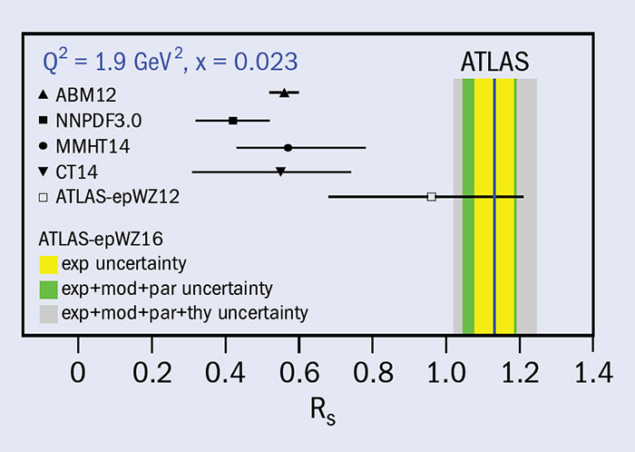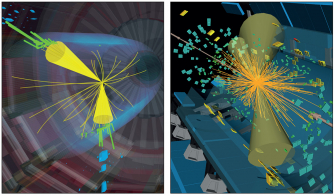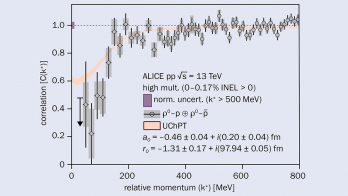
The excellent theoretical understanding of the production of electroweak W and Z gauge bosons in proton–proton collisions at the LHC makes these “standard-candle” processes ideal for studying the detailed performance of the ATLAS detector, and thus improves the precision on measurements. Specifically, differences in the couplings of the W+, W–, Z and γ* bosons to quarks and antiquarks appear as differences in rapidity distributions that reveal additional information about the structure of the proton.
Protons are often considered to be composed of two up quarks and one down quark, but when probed at small distances they reveal additional content. This includes a “sea” of up and down quarks, strange quarks from the heavier second generation of particles, and the gluons that bind the quarks together into the proton.

The ATLAS collaboration has now shed light on the least-known component of the proton – its content of strange quarks – based on sub-per-cent measurements of the kinematic dependencies of the W and Z boson cross-sections using LHC data recorded in 2011 at an energy of 7 TeV. Previous determinations of the strange-quark content of the proton were based on neutrino scattering, in which charged-current interaction muons from the fragmentation of charm quarks were detected. Contrary to theoretical expectations, these data revealed a suppression of strange quarks relative to the up and down quarks.
Gaining further insight into the proton structure using inclusive W and Z boson production required significant experimental improvements, with painstaking calibration efforts revealing detection efficiencies in real and simulated data at the per-mille level using both the electron and muon channels. Indeed, thanks to these studies, the ATLAS data provided a new test of electron–muon universality in the weak-interaction sector that is in excellent agreement with the Standard Model at the sub-per-cent level.
The combined electron and muon data, including the correlations of systematic uncertainties, were compared to predictions performed at next-to-next-to leading order (NNLO) in QCD and next-to-leading order in electroweak theory. Using various parton distribution functions, the comparisons revealed significant tensions between measurement and theory. Interpreting HERA-inclusive deep-inelastic-scattering data including the ATLAS data in an NNLO QCD fit pointed to a new sensitivity to the strangeness suppression factor Rs = (s + s)/(d + u), as shown in the figure. The data confirm with significantly improved precision the previous ATLAS determination of an unsuppressed strange-quark content (shown as ATLAS-epWZ12) based on 2010 data.
The result may have important implications for further precision measurements of Standard Model parameters, in particular the mass of the W boson and the weak-mixing angle, since these are affected by the second generation of quarks. The ATLAS measurement challenges the current paradigm of a suppression of the strange- compared to other light-quark distributions, but the quest continues.








